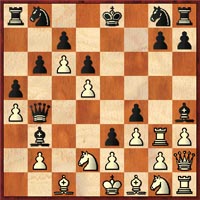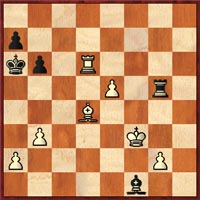 |
 |
 |
 |
 |
 |
 |
 |
 |
 |
 |
 |
 |
 |
|
|
|
|
|
|
|
|
|
|
|
|
|
|
|
|
 |
|
|
|
|
|
|
|
|
|
Generation Chess International Tournament
Round Six
|
|
|
|
|
|
|
|
|
|
|
|
|
|
|
Interesting round. Akobian-Paschall created the first game in the tournament where both players had to play meaningless moves in a dead drawn position. Perelshteyn appears to have a lock on his first GM norm (the other being disallowed). He now has a huge 5½ points and is running away with the tournament. Simutowe beat Ehlvest in an impressive display of control and precision.
***
Akobian-Paschall, ½-½. This game developed slowly out of a King's Indian… white opted to fianchetto both bishops while black sought to drum up play on the kingside. However, the queens were traded quickly and after a mass trading of pieces, an ending of opposite colors ensued after 35.Bxd5. Effectively the game was drawn here, but the two players had to play the obligatory 50 moves before offering a draw. It was reported that the two players smiled at each other as they shuttled their opposite-colored bishops back and forth. After black made his 50th move, a draw was agreed immediately.
|
|
|
|
|
|
|
|
|
|
|
|
|
|
The only exception to this rule would have be in the event of stalemate. In fact, Chess.FM Commentator NM Eric Schiller told a humorous story about the pre-composed stalemate by Jennie Frenklakh and Jennifer Shahade at an Under-16 World Championship tournament. Both were representing the U.S. and were upset that they were paired. After protests went unheeded, they were warned of a penalty if they agreed to a short draw, so they composed a creative stalemate (see diagram). Schiller stated that the 10-move stalemate was somehow botched and it ended up being a 14-move stalemate!
Editor's note: Sometimes the story isn't so nice. Years ago in a Chicago tournament, two players agreed to a pre-arranged draw, but during the game, one player forgot the move order and hung a piece. The other player went on to win the game and the prize.
|
|
|
|
|
|
|
|
|

|
|
|
|
|
|
|
|
|
|
|
|
Frenklakh - J.Shahade, 1994
14-move stalemate
|
|
|
|
|
|
|
|
|
|
|
|
|
|
|
|
|
Krush-Perelshteyn, 0-1. The King's Indian is certainly getting a workout in this tournament. Krush tried some inventive play by sacking a pawn in the center of the board for play on the e-file. Perelshtyen bit the bait and when Krush couldn't muster enough counterplay, she would quickly lose the initiative. Black's rooks dominated the board and gobbled a couple of weakened pawns. After white was forced to trade a pair of rooks, the black king marched up the board to support a pawn advance and white was forced to resign. Krush is a student at New York University and perhaps she is finding mixing high-level chess and the rigors of study a daunting task indeed!
Christiansen-Bluvshtein, 1-0. The famous Tarrasch Defense is one of the most oft-analyzed variations in the Queen's Gambit. It provides black with a lot of play, but one has to be knowledgeable of all the tactical complications. This game was exciting right out of the gate as the young Canadian proved that he wouldn't back down from a fight and played 11…Ng4!? The Internet Chess Club relayed 16…Be6 which loses a piece and the spectators where trying to piece together the correct position. After the mess was cleared, Christiansen won favorable complications and pressure along the e-file. After 22.Rxf7, Bluvshtein held the balance with 22… Qe6 (not 22…Qxf7?? 23.Rxf7 Kxf7 24.Nc3+). Unfortunately, the time pressure bug bit, and Bluvshtein blundered with 28…Nb4?? and after 29.Ne6, black would not only lose material, but would not be able to stop the attack on his king.
Simutowe-Ehlvest, 1-0. Interesting game that created a lot of debates at the ICC. There were apparent loyalties watching this game as there was even someone with the handle "ehlvestfan." Certainly no one could've imagined what would occur… except elite Russian players who are well aware of Simutowe's talents and have a high regard for the 21-year old Zambian. This game may show why.
Playing 1.Nf3 after having played 1.e4 and 1.d4, this shows that Simutowe is adjusting his style to each player. Perhaps he saw something in the database that he could capitalize off of. The opening played has been used by Simutowe with great success having won three previous games in this line. One of these is a memorable win at the Wilbert Paige tournament in which he demolished FM Ronald Simpson after 1. Nf3 Nf6 2. c4 g6 3. Nc3 d5 4. cxd5 Nxd5 5. Qa4+ Bd7 6. Qh4 Nf6 7. e4 Bg7. Ehlvest played 7…c5 instead (preventing the stifling 8.d4) and Simutowe applied the pressure. Many were adamant that Ehlvest was better and even reminded the other spectators that Ehlvest was a Grandmaster.
|
|
|
|
|
|
|
|
|
|
|
|
|
|
A very interesting position occurred after 15.dxc4. Ehlvest had given up tremendous space and was in danger of suffering the same gruesome fate as Simpson if he didn't act fast. However, Simutowe played creatively and kept up the pressure after 15…h4 16. Qe1 Bc6 17. e5 Qd4+ 18. Be3 Qxc4 19. b3! Qe6 20.Bxc5. The position was complicated with 20…g5!? after which no one seemed to know what was going on. With the board smoking, the game cooled off a bit after the exchange of queens, but Ehlvest embarked on a dubious plan of 27…b6 and 27…Kb7 allowing Simutowe to get an unshakeable grip on the position after 30.Ke3. Black couldn't not play 30…Bxg2 because of 31.e6! winning. Ehlvest sought counterplay with his rook, but missed a tactical resource of 34.Nxe6! and the game had to resign a few moves later.
|
|
|
|
|
|
|
|
|

|
|
|
|
|
|
|
|
|
|
|
|
Simutowe-Ehlvest
Final Position
|
|
|
|
|
|
|
|
|
|
|
|
|
|
|
|
|
What is interesting during the game was how the large majority of spectators blindly stated that Ehlvest had a better position throughout the game. Commentator NM Eric Schiller was no different. In fact, he made such comments when Simutowe had an extra pawn, a solid grip on the position and Ehlvest was only a handful of moves from resigning! It demonstrated that Schiller did not know much about Simutowe and did not take him seriously. He even questioned whether this was Simutowe's first win over a Grandmaster… a player with two GM norms and career-high FIDE rating of 2470!! Commentators should do more background research when commentating as to provide the players with a more objective view of the games.
Muhammad-Yudasin, 0-1. Muhammad was again inventive in his opening plan and produced some interesting ideas. However, against such an experienced Grandmaster, this strategy did not reap its full benefits. This game featured intense maneuvering, probing, parries and a wretched pawn configuration for both sides. Yudasin applied the pressure on white's passive position and opened lines with 41…e3!? Spectators were wondering whether to give that move an (!) or an (?) after 42.Nxe3, but after the forcing line of 42…Qe6! 43.Rd3 Bc8 44. Nc2 g5! 45. Be3 Qg4 46. hxg5 hxg5 47. Kg1 Bf5 48. Rd2 Bxc2 white would lose a piece. Muhammad will try to close out the tournament on a positive note in these last three rounds. He'll come out fighting against IM William Paschall. Should be interesting!
Cross Table
Round Six Games (playable and downloadable)
All Games (PGN download)
Standings: Perelshteyn, 5½; Christiansen, Yudasin, 4; Krush, 3½; Bluvshtein, Ehlvest, Simutowe, 3; Akobian, 2; Muhammad, Paschall, 1.
|
|
|
|
|
|
|
|
|
|
|
|
|
|
|
|
|
|
|
|
 |
|
|
|
|
|
 |
|

